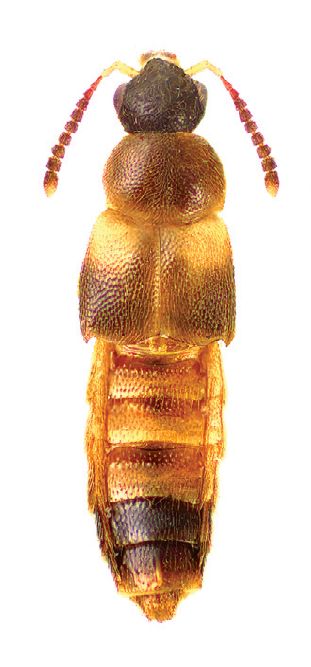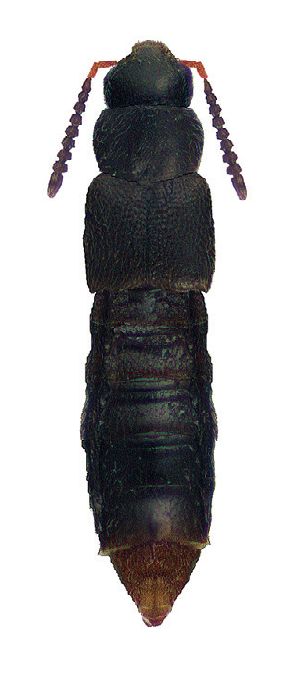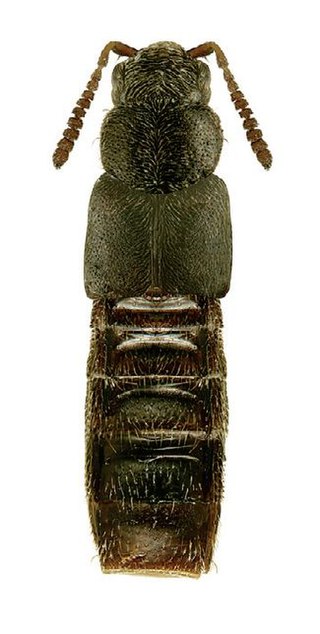
The rove beetles are a family (Staphylinidae) of beetles, primarily distinguished by their short elytra that typically leave more than half of their abdominal segments exposed. With over 66,000 species in thousands of genera, the group is the largest family in the beetle order, and one of the largest families of organisms. It is an ancient group that first appeared during the Middle Jurassic based on definitive records of fossilized rove beetles, with the Late Triassic taxon Leehermania more likely belonging to Myxophaga. They are an ecologically and morphologically diverse group of beetles, and commonly encountered in terrestrial ecosystems.

Aleochara is a genus in the beetle family Staphylinidae, the rove beetles. Larvae of Staphylinidae occur in many assorted ecological roles, most being scavengers, predators or carrion feeders, but the larvae of at least those species of Aleochara whose life histories are known are parasitoids. They feed in the puparia of suitable species of flies, killing the host in the process. Adult Aleochara are predators.

The Aleocharinae are one of the largest subfamilies of rove beetles, containing over 12,000 species. Previously subject to large-scale debate whether the subfamily deserved the familial status, it is now considered one of the largest subfamilies of rove beetles.

A gnat is any of many species of tiny flying insects in the dipterid suborder Nematocera, especially those in the families Mycetophilidae, Anisopodidae and Sciaridae. Most often they fly in large numbers, called clouds. "Gnat" is a loose descriptive category rather than a phylogenetic or other technical term, so there is no scientific consensus on what constitutes a gnat. Some entomologists consider only non-biting flies to be gnats. Certain universities and institutes also distinguish eye gnats: the Smithsonian Institution describes them as "non-biting flies, no bigger than a few grains of salt, ... attracted to fluids secreted by your eyes".

Symphiles are insects or other organisms which live as welcome guests in the nest of a social insect by which they are fed and guarded. The relationship between the symphile and host may be symbiotic, inquiline or parasitic.

Drusilla canaliculata is a species of rove beetle in the family Staphylinidae. It is found in Europe and Northern Asia and North America.

Phymatura blanchardi is a species of rove beetle in the family Staphylinidae.

Phymatura is a genus of rove beetles in the family Staphylinidae. There are at least 2 described species in Phymatura.

Homalotini is a tribe of rove beetles in the family Staphylinidae. There are at least 30 genera and 200 described species in Homalotini.

Leptusa is a genus of rove beetles in the family Staphylinidae. There are at least 20 described species in Leptusa.

Athetini is a tribe of rove beetles in the family Staphylinidae. There are at least 50 genera and 430 described species in Athetini.
Aleodorus bilobatus is a species of rove beetle in the family Staphylinidae. It is found in North America.
Aleodorus is a genus of rove beetles in the family Staphylinidae. There are at least four described species in Aleodorus.

Hoplandria lateralis is a species of rove beetle in the family Staphylinidae. It is found in Central America, North America, and South America.

Hoplandria is a genus of rove beetles in the family Staphylinidae. There are about 13 described species in Hoplandria.

Rugilus rufipes is a species of rove beetle in the family Staphylinidae. It is commonly found across Europe and parts of North America. These beetles are known for their slender bodies and distinctive red legs, which give the species its name.
Tarphiota is a genus in the family of beetles known as Staphylinidae. There are at least three described species in Tarphiota. Members of this genus are found on seashores, in association with decaying seaweed.
Falagria is a genus of rove beetles in the family Staphylinidae. There are more than 30 described species in Falagria.

Atheta novaescotiae is a species of rove beetle in the family Staphylinidae. It is found in North America. It lives in a marine seashore environment, and has adaptations similar to rove beetles of the genus Tarphiota, which also live in these habitats.

Atheta is a genus of rove beetles in the family Staphylinidae. There are more than 640 described species in Atheta.













